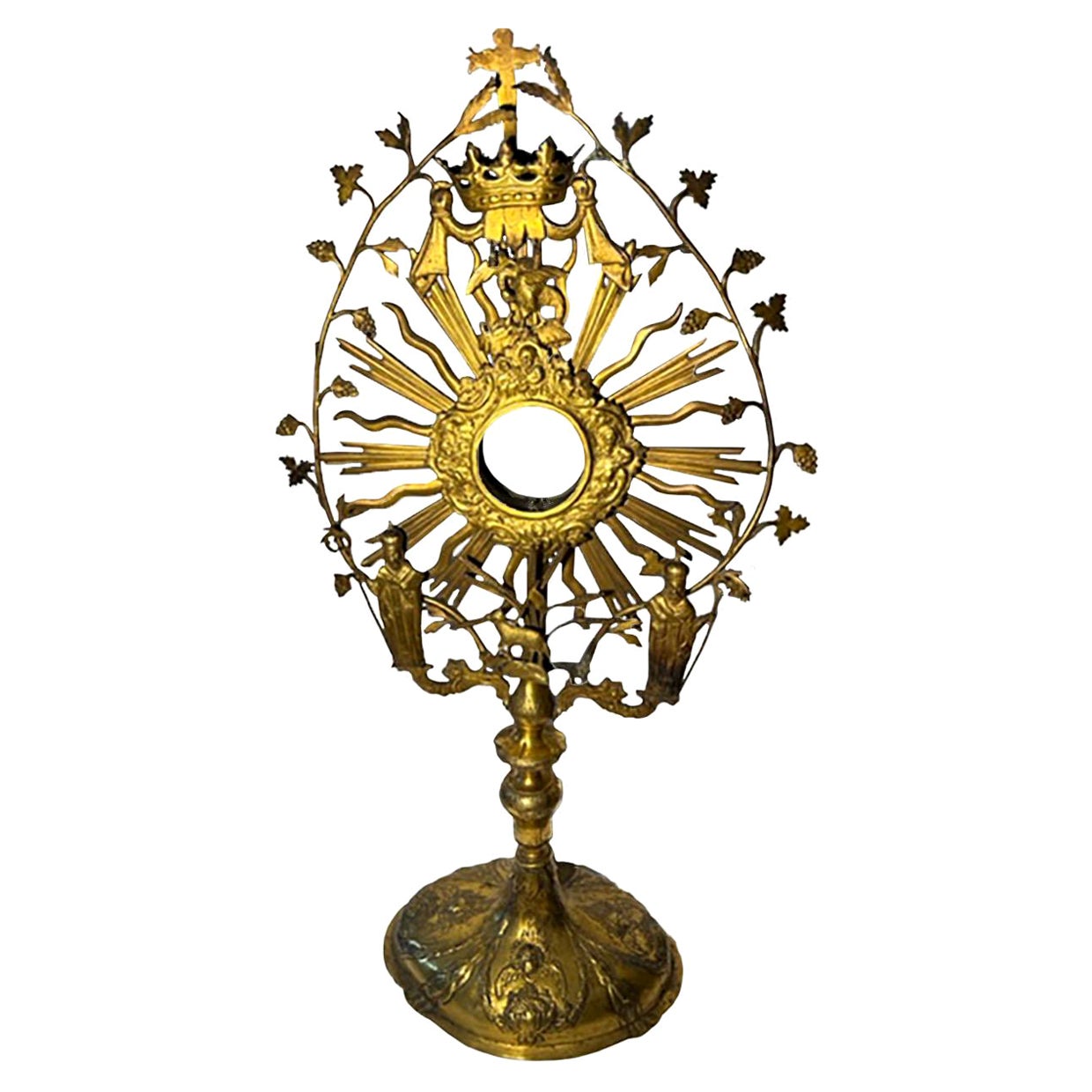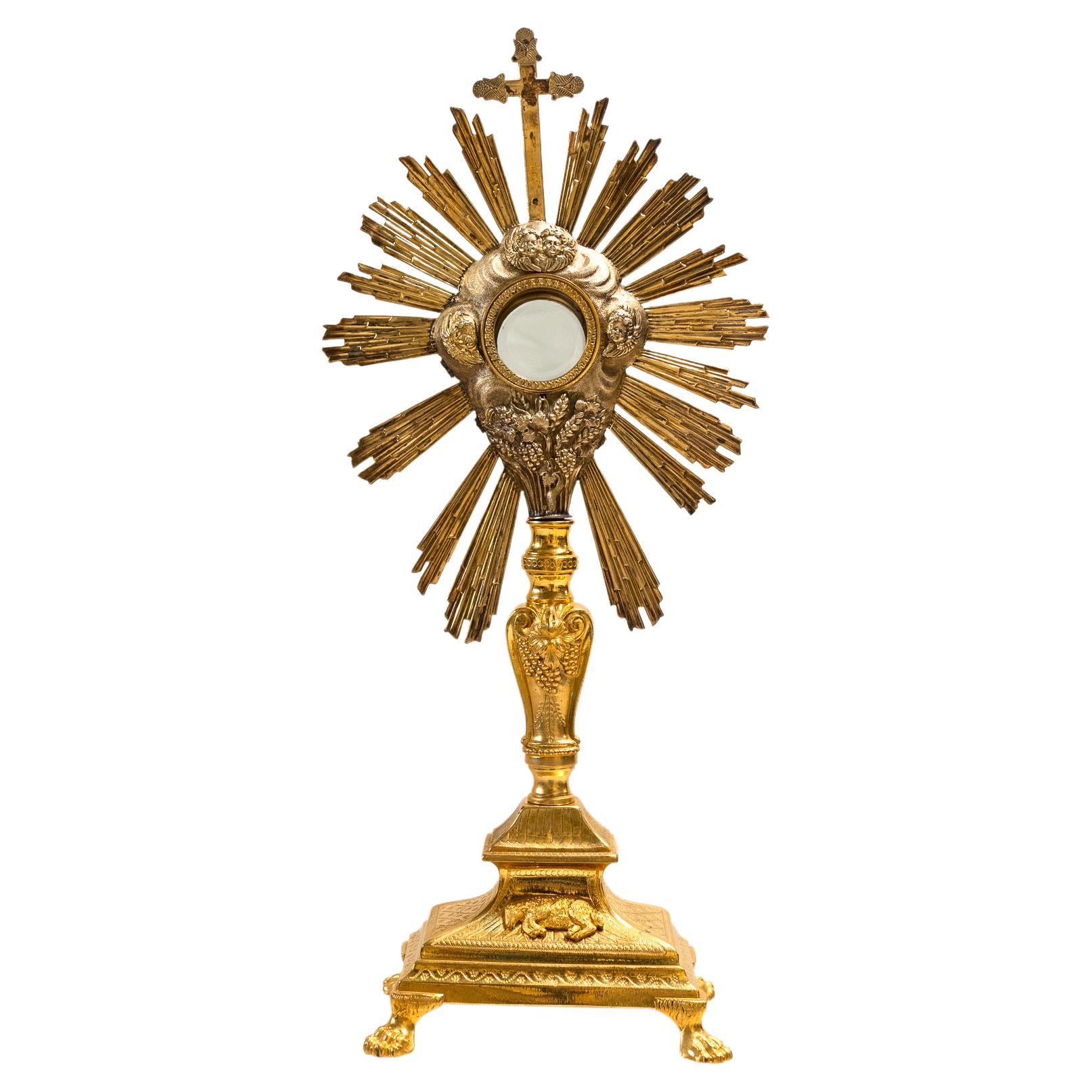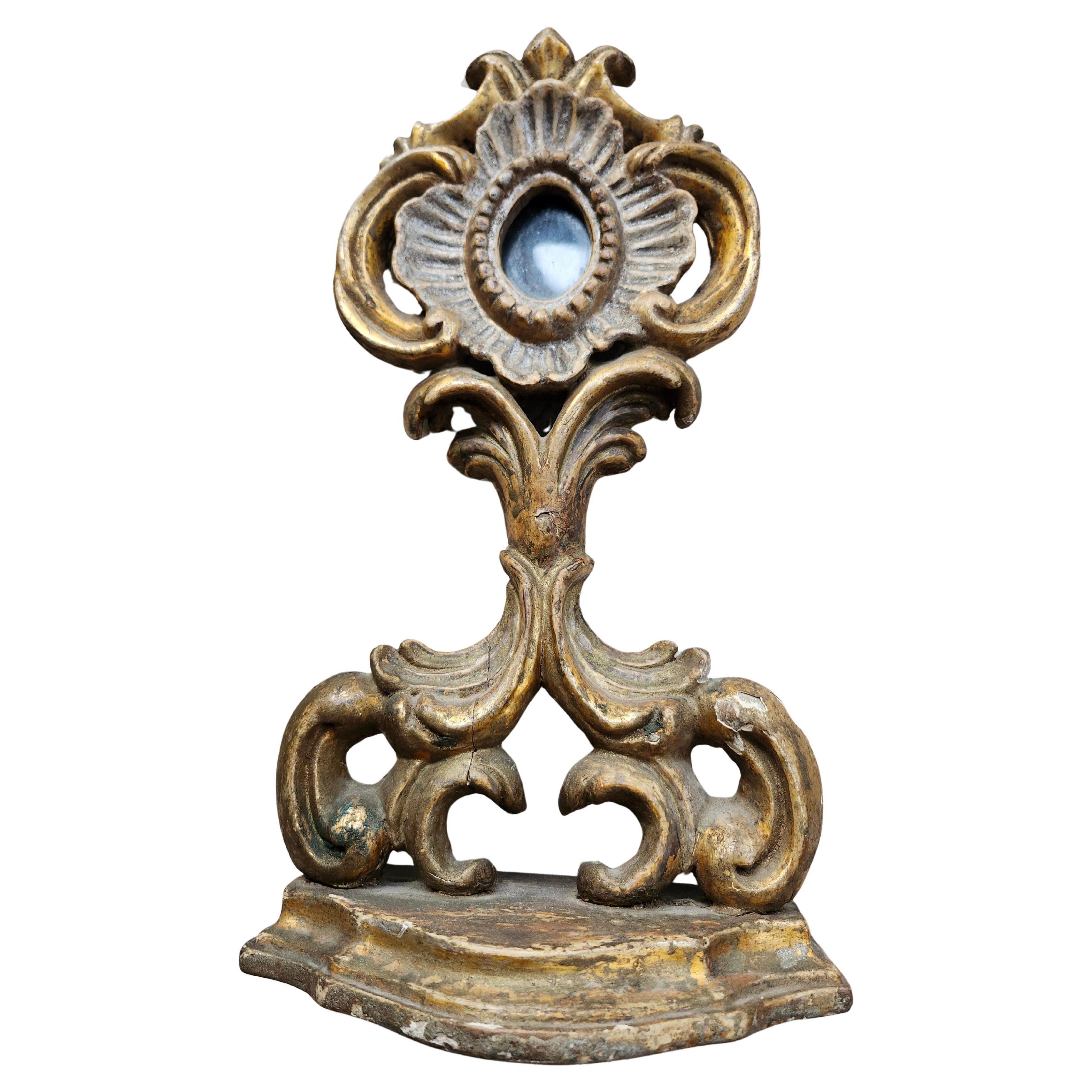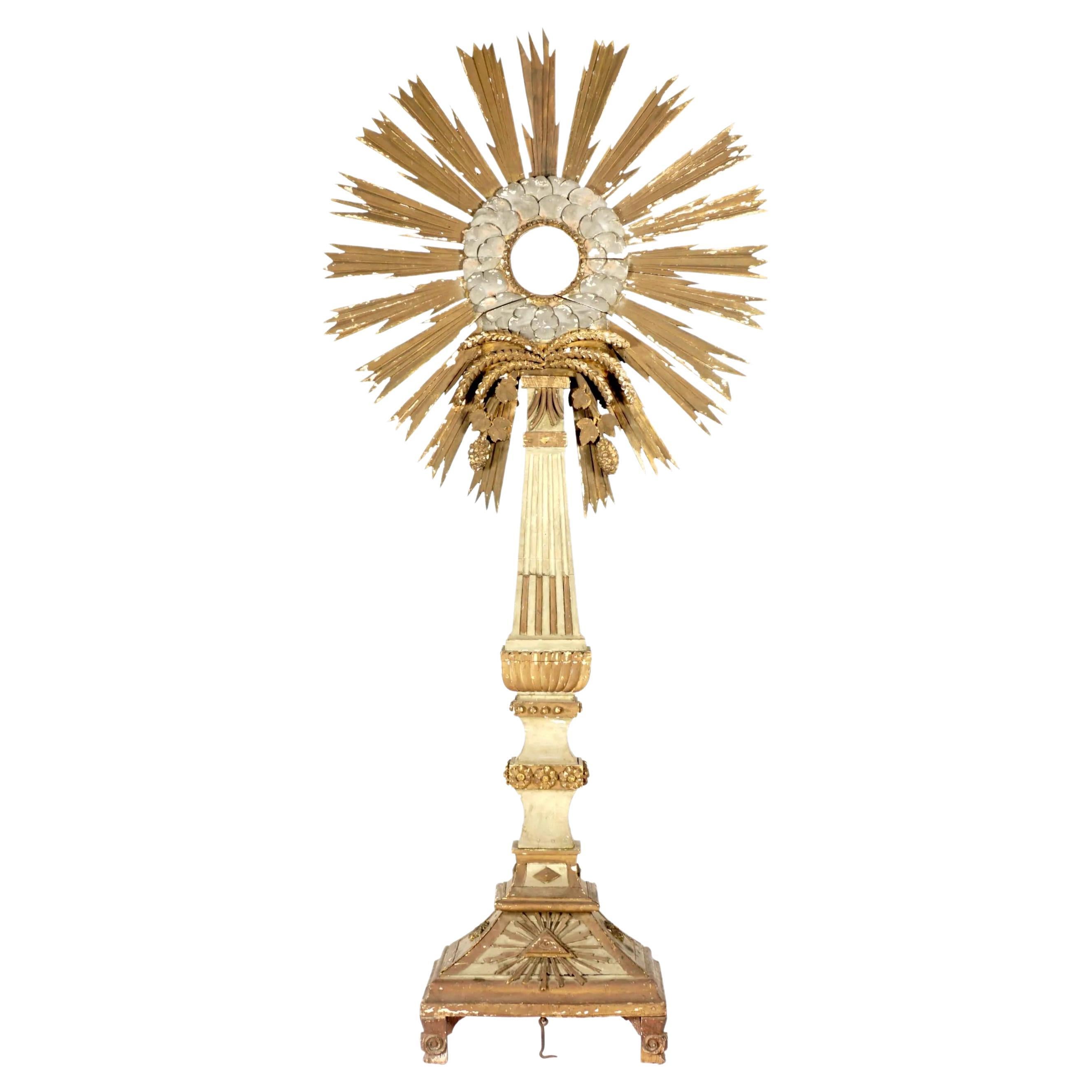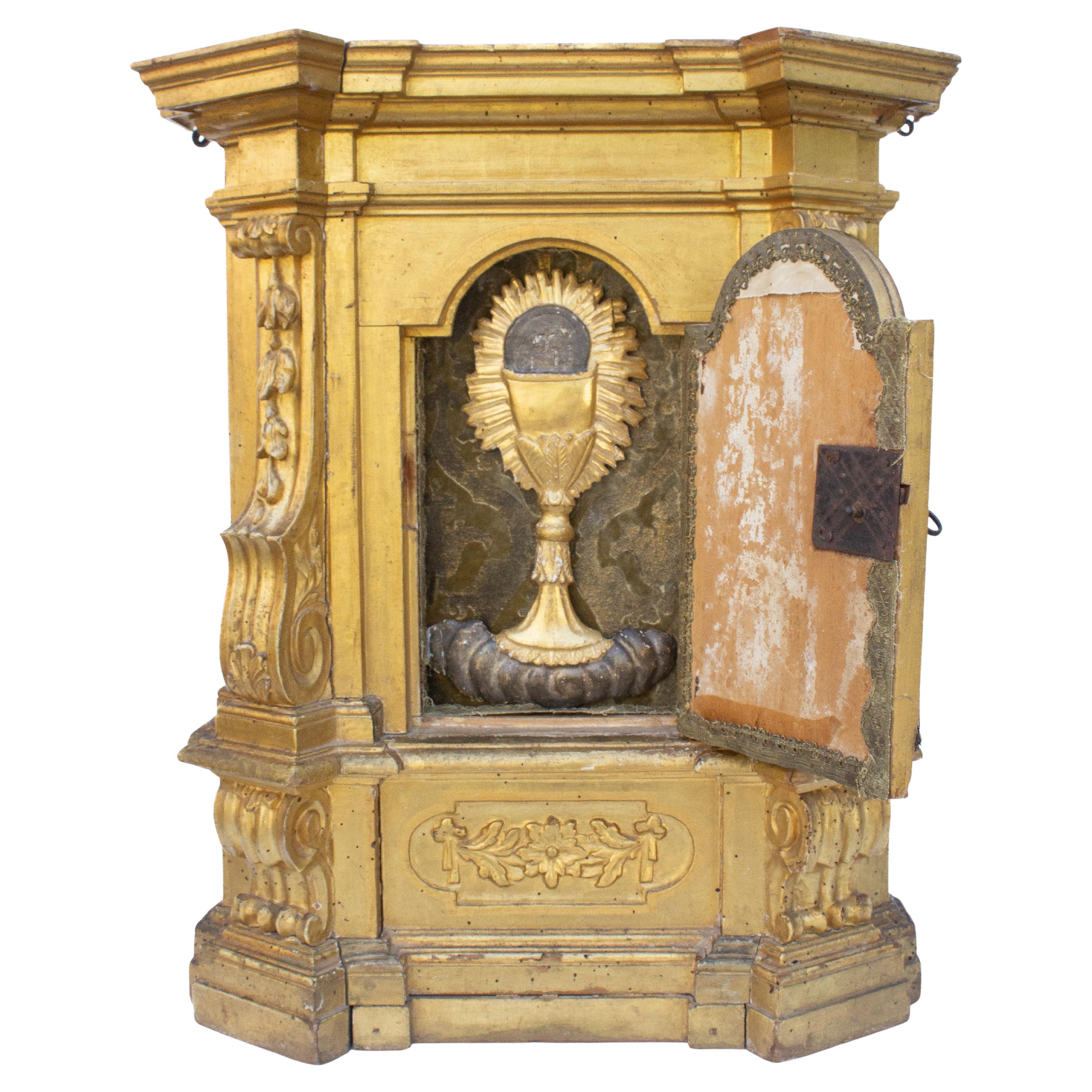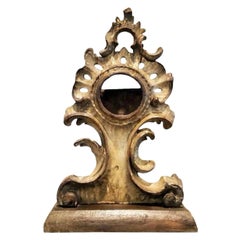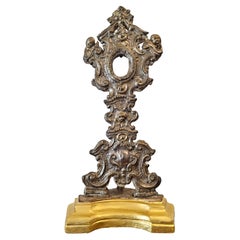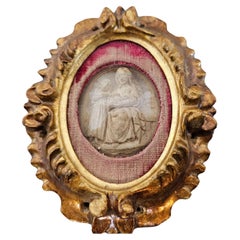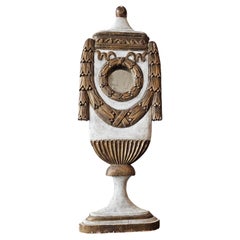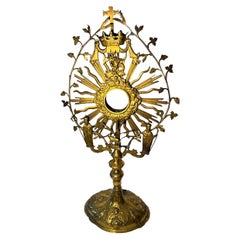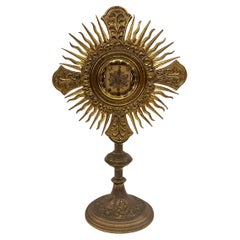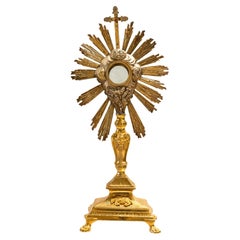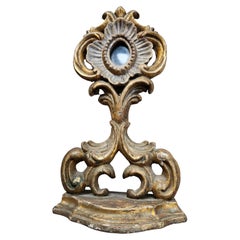Items Similar to Fine 19th Century European Gilt Bronze Ormolu Monstrance Reliquary
Want more images or videos?
Request additional images or videos from the seller
1 of 21
Fine 19th Century European Gilt Bronze Ormolu Monstrance Reliquary
$3,350
£2,539.76
€2,927.67
CA$4,717.94
A$5,231.84
CHF 2,748.95
MX$63,924.24
NOK 34,393.06
SEK 32,283.76
DKK 21,855.64
About the Item
A scarce fine quality neoclassical Empire style vasiform gilt bronze ormolu church religious relic altar monstrance reliquary.
Exquisitely hand-crafted in Continental Europe in the second half of the 19th century, most likely French Napoleon III Period (1852-1870), having a fanned cross crest, above winged angel mask, central oval display window relic host holder with a luna, flanked by pierced floral and foliate bouquet laced with wheat sheaves, handled amphora shaped vase standard, fiolated acanthus leaf scroll accented stand, rising on a pair of figural lion supports, resting on integral shaped plinth base.
Dimensions: (approx)
19.5" High, 7.25" Wide, 4" Deep, 3.3 lbs
Excellent original antique condition. Brilliant gold color. Lightly patinated. Wear consistent with age, including minor scratch to base front. Overall a superb museum quality example
We here at Lynx Hollow Antiques absolutely love to decorate with religious objects,
We here at Lynx Hollow Antiques absolutely love to decorate with religious objects, from all time periods and religions, we love how decorative, interesting, and rich in history they can be. We have many other examples available, including church altars, altarpiece panels, tabernacle, architectural salvaged church, temple, and monastery building elements, reliquaries, retablo icons, rare ecclesiastical - liturgical items, processional lamps, chalices, shrines, folk art carvings, sculptures, temple statues, and much more.
- Dimensions:Height: 19.5 in (49.53 cm)Width: 7.25 in (18.42 cm)Depth: 4 in (10.16 cm)
- Style:Empire (In the Style Of)
- Materials and Techniques:
- Place of Origin:
- Period:
- Date of Manufacture:circa 1860
- Condition:Wear consistent with age and use. Excellent original antique condition. Brilliant gold color. Lightly patinated. Wear consistent with age, including minor scratch to base front. Overall a superb museum quality example.
- Seller Location:Forney, TX
- Reference Number:1stDibs: LU5977233665562
About the Seller
4.8
Platinum Seller
Premium sellers with a 4.7+ rating and 24-hour response times
Established in 2013
1stDibs seller since 2021
296 sales on 1stDibs
Typical response time: <1 hour
- ShippingRetrieving quote...Shipping from: Forney, TX
- Return Policy
Authenticity Guarantee
In the unlikely event there’s an issue with an item’s authenticity, contact us within 1 year for a full refund. DetailsMoney-Back Guarantee
If your item is not as described, is damaged in transit, or does not arrive, contact us within 7 days for a full refund. Details24-Hour Cancellation
You have a 24-hour grace period in which to reconsider your purchase, with no questions asked.Vetted Professional Sellers
Our world-class sellers must adhere to strict standards for service and quality, maintaining the integrity of our listings.Price-Match Guarantee
If you find that a seller listed the same item for a lower price elsewhere, we’ll match it.Trusted Global Delivery
Our best-in-class carrier network provides specialized shipping options worldwide, including custom delivery.More From This Seller
View AllImportant Early 18th Century Italian Carved Monstrance Reliquary Tabernacle
Located in Forney, TX
Important and historic, acquired from the estate of legendary American businessman, the late T. Boone Pickens, we're proud to offer this exceptional carved giltwood reliquary - monstrance from the early 18th century.
Elaborately hand carved in period Rococo - Rocaille taste, with superb scrollwork, openwork, fanciful acanthus leaf and shell, ornate detailing, polychrome painted warm pastel colors, now beautifully distressed, muted tones, with remnants of gold gilded accents.
Pieces such as this were used in early churches for convenient exhibition or public display of some object of piety and other important religious relics...
Category
Antique Early 18th Century Italian Rococo Religious Items
Materials
Giltwood
18th/19th Century Italian Baroque Silvered Metal Altar Monstrance Reliquary
Located in Forney, TX
A stunning antique Italian Baroque style silvered metal gilded wood monstrance reliquary. circa 1770-1820
Handmade in Italy in the late 18th / early 19th century, commissioned by the church to display an important religious relic, sculptural painted wood form, mounted with decorative silver repousse metal facing, open oval window where the philatory relic was once housed, rising on a gold gilt painted shaped plinth base.
Dimensions: (approx)
17" High, 8" Wide, 5" Deep, 1.25lbs
History:
Reliquaries (also referred to as a shrine or châsse in French), are containers used to protect and display relics. A portable reliquary may be called a fereter, and a chapel in which it is housed a feretory. A monstrance, also known as an ostensorium (or an ostensory), is a vessel used in Roman Catholic, Old Catholic, High Church Lutheran and Anglican churches for the display on an altar of some object of piety, such as the consecrated Eucharistic host during Eucharistic adoration or Benediction of the Blessed Sacrament. It is also used as reliquary for the public display of relics of some saints.
The use of reliquaries became an important part of Christian practices from at least the 4th century, initially in the Eastern Churches, which adopted the practice of moving and dividing the bodies of saints much earlier than the West, probably in part because the new capital of Constantinople, unlike Rome, lacked buried saints. Relics are venerated in the Oriental Orthodox, Eastern Orthodox, Roman Catholic and some Anglican Churches. Reliquaries provide a means of protecting and displaying relics. While frequently taking the form of caskets, they range in size from simple pendants or rings to very elaborate ossuaries.
The relics were enshrined in containers crafted of or covered with gold, silver, gems, and enamel. These objects constituted a important form of artistic production across Europe and Byzantium throughout the Middle Ages.
Many were designed with portability in mind, often being exhibited in public or carried in procession on the saint's feast day or on other holy days. Pilgrimages often centered on the veneration of relics. The faithful often venerate relics by bowing before the reliquary or kissing it; those churches which observe the veneration of relics distinguish between the honor given to the saints and the worship that is due to God alone.
Sixteenth-century reformers such as Martin Luther opposed the use of relics since many had no proof of historical authenticity and objected to a cult of saints. Many reliquaries, particularly in northern Europe, were destroyed by Calvinists or Calvinist sympathizers during the Reformation...
Category
Antique Early 19th Century Italian Baroque Sculptures and Carvings
Materials
Metal
Antique Italian Religious Giltwood Reliquary Relief Carved Sculpture
Located in Forney, TX
A rare antique Italian giltwood framed reliquary. 18th/19th century, hand carved giltwood frame housing an exceptional relief carving, d...
Category
Antique Early 19th Century Italian Baroque Religious Items
Materials
Bone, Giltwood
Large 19th Century Neoclassical Carved Painted Gilt Wood Mirrored Urn Statue
Located in Forney, TX
A scarce, large and most impressive European antique urn-form mirrored wooden statue.
Late 19th century, most likely Italian, possibly French, hand carved, painted and gilded solid...
Category
Antique 19th Century European Neoclassical Revival Religious Items
Materials
Mirror, Wood, Giltwood, Paint
Fine 19th Century French Neo-Gothic Gilt Metal Cathedral Church Reliquary Pair
Located in Forney, TX
A stunning pair of very fine quality French Neo-Gothic gilt metal church reliquaries. circa 1860s
Most impressive objets d’art, born in France in the second half of the 19th century, most likely Parisian gilded bronze and brass ormolu work, exceptionally executed sculptural form, the exquisitely detailed architectural cathedral shaped case having a removable pointed steeple roof with cross finial, opening to relic display case surrounded on all sides by original glazed glass panes, stepped base, rising on disc feet. Signed, stamped by maker / bronzier "BC" (unknown) model "5096" and other faint marks to lid interiors.
Additional photos available upon request
Dimensions: (approx)
14.75" High, 6.75" Wide, 6.75" Deep; 13.25 lbs total
History:
A reliquary (also referred to as a shrine, by the French term châsse or monstrance) is a container for important religious relics.
The earliest reliquaries were essentially boxes, either simply box-shaped or based on an architectural design, taking the form of a model of a church with a pitched roof. These latter are known by the French term chasse, and typical examples from the 12th to 14th century have wooden frameworks with gilt-copper plaques nailed on, decorated in champlevé enamel. Limoges was the largest production centre; NB the English usage differs from that of the French châsse, which denotes large size rather than shape.
Relics of the True Cross became very popular from the 9th century onward and were housed in magnificent gold and silver cross-shaped reliquaries decorated with enamels and precious stones. From about the end of the 10th century, reliquaries in the shape of the relics they housed also became popular; hence, for instance, the skull of Pope Alexander I was housed in a head-shaped reliquary. Similarly, the bones of saints were often housed in reliquaries that recalled the shape of the original body part, such as an arm or a foot.
A philatory is a transparent reliquary designed to contain and exhibit the bones and relics of saints. This style of reliquary has a viewing portal to view the relic inside. The feretrum was a medieval form of reliquary or shrine containing the sacred effigies and relics of a saint.
During the later Middle Ages, the monstrance form, primarily used for consecrated hosts, was sometimes used for reliquaries. These housed the relic in a rock crystal, or glass capsule mounted on a column above a base, enabling the relic to be displayed to the faithful. Reliquaries in the form of large pieces of metalwork jewellery also appeared around this time, housing tiny relics such as pieces of the Holy Thorn, notably the Holy Thorn Reliquary now in the British Museum.
Condition:
Superb museum quality examples, in excellent original unrestored antique condition with beautifully aged patina. Wear consistent with age and use. Heavily patinated - scattered oxidation. Overall wonderful examples.
Typically reliquaries were not sold in pairs, so to find a matching pair such as this is exceptionally rare.
Worldwide shipping available
Local pickup available near Dallas, Texas
Additional:
We here at Lynx Hollow Antiques love religious antiques, from Christian tabernacles, Catholic altarpiece, life-size Buddhist temple sculptures, Hindu votive offerings, 16th century Islamic mosque architectural salvaged windows...
Category
Antique Mid-19th Century French Gothic Revival Religious Items
Materials
Brass, Bronze
Antique Neo-Gothic Gilt Bronze Pricket Candlestick
Located in Forney, TX
A stunning Late Victorian Neo-Gothic gilt bronze altar stick pricket candlestick. Late 19th to early 20th century, the Continental European antique features an exceptionally executed...
Category
Antique Late 19th Century European Gothic Revival Candlesticks
Materials
Bronze, Ormolu
You May Also Like
Late 18th Century Gilded Italian Monstrance
Located in Dallas, TX
Monstrance gilded with bishops, bird, lamb and cross. Gilded base with angels is 10” x 7.5”. Circa 1780-1810, Italian.
Category
Antique 1780s Italian Religious Items
Materials
Metal
Antique Gilt Bronze Reliquary
Located in New York, NY
A late 19th Century French gilt bronze reliquary with removable glass insets that hold an embroidered sachet.
Measurements:
Height: 14.5"
Diameter: 9"
Category
Antique Late 19th Century French Religious Items
Materials
Bronze
19th Century Silver and Gold Monstrance with Travel Case
Located in Ross, CA
A silver and gold monstrance with travel case (c. 1890). Also known as an ostensorium, this vessel was used as a reliquary for display in the private r...
Category
Antique Late 19th Century French Neoclassical Religious Items
Materials
Gold Plate, Silver, Bronze
$2,760 Sale Price
20% Off
18th Century Italian Hand Carved Baroque Giltwood Reliquary
Located in Port Jervis, NY
18th century reliquary from northern Italy. Giltwood, polychromed and looks to be hand carved from one piece of wood. Mortised thru the base.
A reliquary was used to house a religio...
Category
Antique 1750s Italian Baroque Abstract Sculptures
Materials
Glass, Giltwood
Early 19th Century Italian Giltwood Neoclassical Sunburst Monstrance
Located in Essex, MA
Large neoclassical Italian giltwood sunburst on original large base. Monstrance. Sun rays and palmettes. Parcel gilt column with rayed being eye. Illuminati symbolism.
Category
Antique Early 19th Century Italian Neoclassical Architectural Elements
Materials
Pine, Giltwood
18th Century Italian Gilded Tabernacle with a Hand-Carved Chalice Fragment
By Interi
Located in Dublin, Dalkey
18th century Italian gilded and hand-carved tabernacle adorned with an 18th century Italian gilt chalice and Sabina Faye Braxton gaufrage fabric. This tabernacle once belonged in a h...
Category
Antique 18th Century Italian Rococo Religious Items
Materials
Gold Leaf
